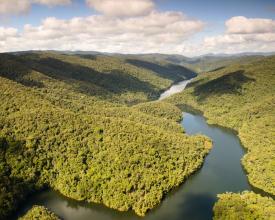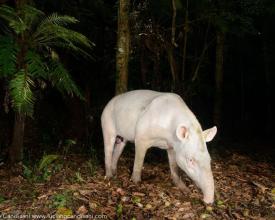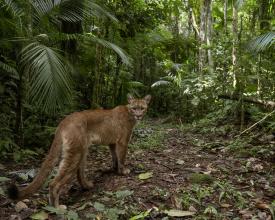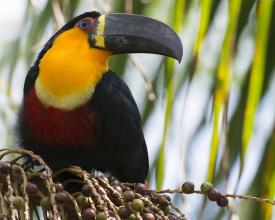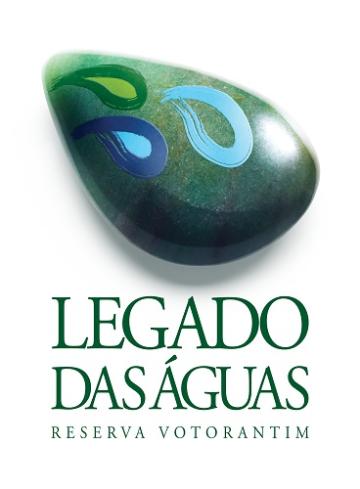
Legado das Águas - Reserva Votorantim (Legado de las Aguas)
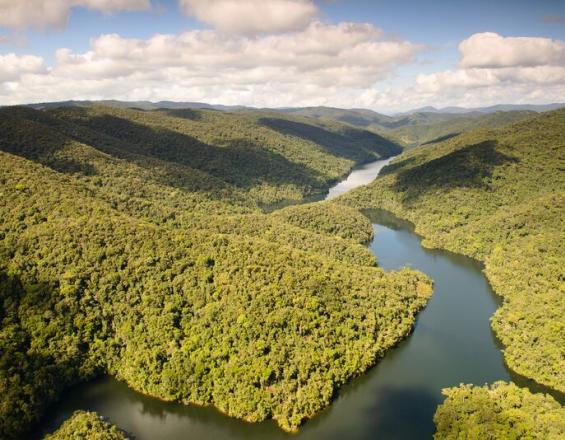
El Legado das Águas (Legado de las Aguas), la mayor reserva privada de la Mata Atlántica brasileña, con 31.000 hectáreas, es uno de los activos medioambientales de la empresa Votorantim. Situada en la región de Vale do Ribeira, en el sur del estado de São Paulo, el área fue adquirida en la década de 1940 y desde entonces se ha conservado con el objetivo de garantizar, a largo plazo, el recurso hídrico de la cuenca del río Juquiá.
Hoy en día, el Legado das Águas está gestionado por la empresa Reservas Votorantim LTDA, creada para establecer e implantar un nuevo modelo de gestión de activos medioambientales.
En este sentido, el Legado das Águas se estructuró de forma que promoviera acciones dentro de cuatro ejes centrales: Gestión Institucional, Capital Humano y Social, Capital Económico y Capital Natural, demostrando que el uso sostenible de los recursos naturales de las áreas protegidas privadas posibilita la inversión en el mantenimiento del área, así como beneficios sociales y económicos.
Contexto
Défis à relever
Una de las barreras impuestas al Legado das Águas es su no reconocimiento como iniciativa voluntaria (sino de compensación medioambiental).
Entre las demás barreras encontradas por la Reserva, hay cinco prioritarias:
- Cuestiones políticas que siguen impregnando los procesos y las relaciones con los actores clave (reto social);
- Dificultad de implicar a todos en la consecución de los mismos objetivos (reto social);
- Alcance del equilibrio financiero entre la cantidad invertida y los ingresos obtenidos (reto económico);
- Inversión para el mantenimiento de todos los programas y proyectos en los años siguientes (reto económico); e
- Inhibir la presencia de invasores (palmeras de Juçara y animales cazadores) (reto social y medioambiental).
Ubicación
Procesar
Resumen del proceso
El Protocolo de Intenciones firmado con el Gobierno del Estado de São Paulo establece un modelo de gestión compartida. Por lo tanto, el Legado das Águas debe informar de sus acciones, obras y resultados alcanzados a lo largo de cada año. Este informe tiene el efecto de informar al gobierno de que lo prometido se está cumpliendo. En este sentido, el Plan Estratégico de Gestión es esencial, ya que orienta todas las decisiones y acciones promoviendo los resultados que se reportan y demuestran los esfuerzos realizados en la gestión innovadora del Legado das Águas para la generación de valor compartido entre bosque, territorio y empresa .
Bloques de construcción
Protocolo de intenciones
En 2012, el Legado das Águas fue reconocido como Reserva Privada de Desarrollo Sostenible (RPDS) a través de una asociación con el Gobierno del Estado de São Paulo. Desde entonces, Votorantim S.A. ha firmado un protocolo de intenciones, donde se compromete a proteger el área que forma el Legado das Águas . Entre los términos firmados en el acuerdo está la propuesta de gestión compartida entre Votorantim Reservas LTDA y el Gobierno del Estado de São Paulo, facilitando avances en estudios científicos, educación ambiental, uso público, protección de especies amenazadas, desarrollo socioeconómico de la región y, principalmente, conservación forestal.
O objetivo desta parceria é fortalecer o trabalho desenvolvido no Legado das Águas e reconhecer a importância da área para a conservação da biodiversidade brasileira pelo poder público.
Factores facilitadores
Para celebrar este protocolo por ambas partes interesadas, es necesario que el documento describa la importancia de la conservación de la zona para garantizar la supervivencia de la biodiversidad y los diversos beneficios generados por los servicios que presta la zona, tanto locales como regionales y mundiales.
Lección aprendida
El compromiso del poder público es un elemento esencial para el consenso en la celebración del protocolo de intenciones. Sin embargo, este compromiso se debe a la comprensión del nuevo modelo de gestión de las áreas protegidas privadas, asociado a la comprensión de los objetivos que guían las acciones de la empresa, en el caso de Reservas Votorantim LTDA, y cómo estos objetivos están en sinergia con las necesidades del poder público.
Recursos
Plan Estratégico de Gestión
Entre 2012 y 2014, se desarrolló el Plan Estratégico de Gestión en colaboración con CI - Conservation International, documento que define el objetivo y la estrategia de gestión de Legado das Águas, abarcando el plan de negocio y el plan de gestión en un único documento . Dividido en tres volúmenes - Diagnóstico; Zonificación; Estrategias y Programas de Desarrollo - el Plan Estratégico orienta todas las acciones hacia los objetivos centrales. En este sentido, se ha avanzado en lo que respecta al desempeño social con la implantación de programas de estructuración organizativa y formación en el territorio en el que se inserta el Legado das Águas, así como con la apertura de la zona para actividades de ecoturismo y el desarrollo de un centro de investigación científica de conservación de la biodiversidad.
Factores facilitadores
Para elaborar un documento de la envergadura del Plan Estratégico de Gestión, es esencial una amplia inversión en investigación para reconocer la zona, la fauna y la flora. Además, comprender la cultura y el contexto, tanto social como político, en el que se inserta el Legado das Águas es una pauta necesaria para garantizar la supervivencia de la empresa y el compromiso de todas las partes interesadas. Cabe mencionar que un estudio de mercado minucioso y detallado es más que esencial para que la estrategia sea eficaz.
Lección aprendida
El Plan Estratégico de Gestión debe estar alineado con la realidad de la empresa, ya que su uso no es sólo para consulta, sino como acción orientadora de la empresa.
Otro hecho importante es el compromiso de todas las partes interesadas para la construcción participativa del plan estratégico de gestión.
Impactos
El Legado das Águas es la mayor reserva privada de Mata Atlántica del país y contribuye a la efectividad del mayor corredor continuo de este bioma; todas las actividades de la Reserva generan externalidades positivas para el territorio, para el bosque y para las personas. En reuniones y eventos, la reserva se presenta como una iniciativa de protección del bosque en pie y de los servicios ecosistémicos. Además, en las actividades desarrolladas para públicos externos se aplican acciones que contribuyen al debate sobre la necesidad e importancia de la conservación, buscando el compromiso de este público.
É também foco do Legado das Águas contribuir para o desenvolvimento do Vale do Ribeiro. O trabalho da reserva nos municípios tem como motor a geração de valor. Assim, o Legado investe em programas de estruturação dos governos municipais, reforço comunitário e melhoramento da educação. Estas acciones tienen como objetivo armonizar la protección del bosque, el fortalecimiento de la sociedad y las actividades de la nueva economía.
Beneficiarios
Organizaciones públicas y consejos municipales relacionados con el turismo, la educación, la agricultura y el medio ambiente; empresarios locales de
medios de alojamiento y producción alimentaria; directores y coordinadores pedagógicos de redes educativas.
Objetivos de Desarrollo Sostenible
Historia
El Vale do Ribeira, donde se inserta el Legado das Águas, posee la mayor superficie continua de Mata Atlántica preservada de Brasil. Pero, por otro lado, también tiene una puntuación en el Índice de Desarrollo Humano (IDH) inferior a la media nacional y la peor del Estado de São Paulo. Este hecho agrava otros problemas existentes, como la deforestación, el palmar y la caza.
La presencia de Votorantim S.A. en el Vale do Ribeira se inició con la construcción de las centrales hidroeléctricas del Complejo Juquiá, acompañada de una serie de adquisiciones de áreas con cobertura vegetal en las márgenes del río Juquiá. Estas áreas, secundando la visión de la dirección de la empresa, eran esenciales para la perennidad del río.
El conjunto de áreas adquiridas a lo largo de los años hizo posible la creación del Legado das Águas , la mayor reserva privada de la Mata Atlántica brasileña, con 31.000 hectáreas de vegetación en avanzado estado de conservación. Estructurado sobre la ideología de la nueva economía, el Legado promueve acciones dentro de cuatro ejes centrales, Gestión Institucional, Capital Natural, Capital Humano-Social y Capital Económico, con el objetivo de contribuir al desarrollo de la región, generar ingresos para la empresa y, principalmente, mantener la selva en pie.
En este sentido, el Legado das Águas ha contribuido activamente al desarrollo económico, basado en el principio de la sostenibilidad, y al compromiso sociopolítico en el Vale do Ribeira.
Desde una perspectiva más profunda, elLegado das Águas estuvo presente en la construcción de hitos jurídicos esenciales para el desarrollo territorial de los municipios en los que se inserta. Como ejemplo, podemos citar el Plan Director de Tapiraí, el Plan Regional Integrado de Turismo y los Planes de Saneamiento Básico de Juquiá y Miracatu.
Estos resultados son fruto del trabajo realizado por los diversos programas implementados por la Reserva en asociación con el poder público, la sociedad y las instituciones, a saber: AGP (Apoyo a la Gestión Pública), PVE (Programa Votorantim de Educación), ReDes (Redes para el Desarrollo Sostenible ); en asociación con el BNDES, y Participación y Emprendimiento Comunitario.
Además, el Legado das Águas , por su actuación y finalidad, demostró ser un importante polo de estudios científicos aplicados a la conservación. Hasta la fecha, se han identificado más de 1.700 especies de fauna y flora como resultado de las asociaciones establecidas por la Reserva para concienciar sobre la importancia de la biodiversidad.

